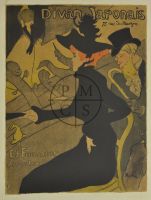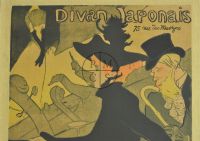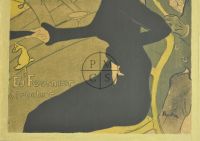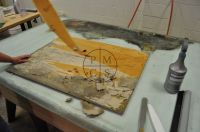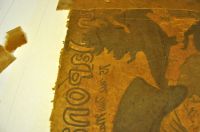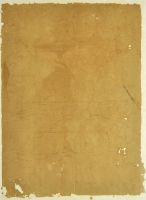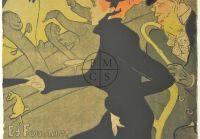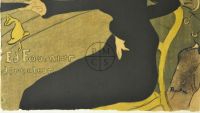DIVAN JAPONAIS
Henri de Toulouse-Lautrec, Color lithograph, 1893, Publisher: Édouard Fournier, Paris. Printer: Edward Ancourt, Paris.
This poster is attached to a cardboard and paper backing with tape covering all sides. Poster is browning.
History of Divan Japonais:
The Divan Japonais, a cabaret in Montmartre, an artists' quarter in Paris, was newly redecorated in 1893 with fashionable Japanese motifs and lanterns. Its owner, Édouard Fournier, commissioned this poster—depicting singers, dancers, and patrons—from Toulouse-Lautrec to attract customers to the opening of his nightclub. In the immediate foreground, Toulouse-Lautrec depicts two of his good friends in the audience: on the right, Édouard Dujardin, an art critic and founder of the literary journal Revue wagnérienne, and, at the center, the famous cancan dancer Jane Avril, whose elegant black silhouette dominates the scene. In the background, another well-known entertainer of the period, the singer Yvette Guilbert, performs on stage. Although her head is abruptly cropped in this composition—reflecting the influence of photography and Japanese prints—Guilbert was immediately known to contemporary patrons by the dramatic gesture of her signature long black gloves.
[From MoMA NY @www.moma.org]
This poster is attached to a cardboard and paper backing with tape covering all sides. Poster is browning.
History of Divan Japonais:
The Divan Japonais, a cabaret in Montmartre, an artists' quarter in Paris, was newly redecorated in 1893 with fashionable Japanese motifs and lanterns. Its owner, Édouard Fournier, commissioned this poster—depicting singers, dancers, and patrons—from Toulouse-Lautrec to attract customers to the opening of his nightclub. In the immediate foreground, Toulouse-Lautrec depicts two of his good friends in the audience: on the right, Édouard Dujardin, an art critic and founder of the literary journal Revue wagnérienne, and, at the center, the famous cancan dancer Jane Avril, whose elegant black silhouette dominates the scene. In the background, another well-known entertainer of the period, the singer Yvette Guilbert, performs on stage. Although her head is abruptly cropped in this composition—reflecting the influence of photography and Japanese prints—Guilbert was immediately known to contemporary patrons by the dramatic gesture of her signature long black gloves.
[From MoMA NY @www.moma.org]
As poster arrived. It is mounted to a cardboard and paper backing approximately 1/4" thick. Tape is covering all sides.
Removal of the final layer of paper. This paper was extremely acidic and was probably the primary cause of paper discoloration and deterioration.
The borders are jagged all around. Because the borders were covered by tape, we did not know what condition to anticipate once the tape was removed.
After removal of the backing board and paper. Poster is temporarily adhered (face down) to a museum board using a gelatin technique.
After restoration.
Note: the black color is more vibrant when viewed in person. No flash or artificial lighting was used in the photography, no photoshop was done to alter the appearance.
Note: the black color is more vibrant when viewed in person. No flash or artificial lighting was used in the photography, no photoshop was done to alter the appearance.
Procedures
Poster was soaked in water and cardboard backing was removed by hand. Once all layers were removed the poster was adhered face-down on a museum board to dry overnight. Poster was then removed from museum board, mounted to Okawara paper using a water-soluble combination PVA adhesive and allowed to dry overnight. Protective hollytex covering was removed and excess gelatin was cleaned from the surface.Larger holes were filled with a compound; smaller areas of loss were not filled, rather, restoration was applied directly to the backing paper. Restoration was performed using colored pencil.
Conclusion
COMPLETED ON 07/20/2010Disclaimer
The object and/or subject of this report is private property. This page is for informational purposes only. Unless clearly stated otherwise, all conservation and restoration has been performed by Poster Mountain (PM) or Los Angeles Paper Group (LAPG)I) PM-LAPG has not knowingly withheld any significant information from its evaluation report and to the best of its knowledge all statements and evaluations in this report are true and correct.
II) PM-LAPG stated in the Evaluation Report its own personal, unbiased and professional analysis, opinions and conclusions, which are subject to the assumptions and limited conditions in this evaluation report as set forth hereinabove.
III) PM-LAPG has no present or prospective interests in the property which is the subject matter of this report and it has no present or prospective personal interests or bias with respect to the participants in this matter.
IV) PM-LAPG and its employment and/or compensation for performing this evaluation or any future anticipated evaluation was not conditioned on any agreement or understanding, written or otherwise, that it would report (or present analysis in support) as predetermined specific authenticity, a predetermined evaluation that favors the cause of any party or the attainment of any specific result or occurrence of a specific subsequent event, such as value or marketability.
V) PM-LAPG prepared all opinions and conclusions about the subject property that were set forth in this Evaluation Report. If it has relied on significant evaluation assistance from any individual or individuals in the performance of this evaluation or the appropriation of this evaluation report, PM-LAPG has named such individuals and disclosed the specific task performed in this evaluation report. PM-LAPG certifies that any individual so named is qualified to the same extent as PM to perform the task. PM-LAPG has not authorized anyone to make a change to any item in this evaluation report, therefore, any change made to this evaluation is unauthorized and PM-LAPG will not take responsibility for it.
VI) The Client may not disclose or distribute this Evaluation Report to any potential purchasers of the subject property without first obtaining PM-LAPG's prior written consent. This consent must be obtained before this evaluation report may be disclosed or distributed to any other party, including, but not limited to, the public through advertising, public relations, news, sales, or other media.

